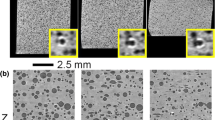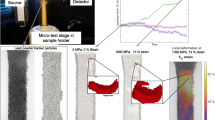Abstract
Use of the Digital Volume Correlation (DVC) technique has grown steadily in the mechanics community as a way of quantifying internal mechanical response of complex microstructures under loading. The DVC technique has been combined with internal imaging methodologies such as X-ray microcomputed tomography (X-ray microCT), confocal microscopy, and photoelasticity enabling many full field studies of bone, foam, rock, polymers, and metals. Despite all these efforts, many DVC limitations remain unknown such as those of “optimal” subset size, step size, and the quality of an internal speckle pattern. Here we investigate in detail the effects of internal speckle patterning on DVC. To help determine the optimum setup for DVC, we develop internal speckle patterns using markers ranging from 5 to 50 μm particles and study these over different resolution length scales. A correlation of pattern size and quality was determined using baseline (i.e., no deformation) and rigid body motion experiments, resulting in a recommended pattern quality parameter. We then performed a uniaxial compression experiment using the optimal pattern determined from the parametric study where we compare accuracy using DVC calculated strains and displacements with theoretical values. An in situ uniaxial compression test demonstrated DVC capabilities resulting in a 2 % error in strain computations.











Similar content being viewed by others
References
Bruck HA, McNeill SR, Sutton SR, Peters WH III (1989) Digital image correlation using newton-raphson method of partial differential correction. Exp Mech 29:261–267
Sutton MA, Wolters WJ, Peters WH III, Ranson WF, McNeill SR (1983) Determination of displacements using an improved digital image correlation method. Image Vis Comput 1(3):133–139
Sutton MA, Orteu J-J and Schreir H (2009) Image correlation for shape, motion and deformation measurements: basic concepts, theory and applications. Springer
Bay BK, Smith TS, Fyhrie DP, Saad M (1999) Digital volume correlation: three-dimensional strain mapping using x-ray tomography. Exp Mech 39(3):217–226
Ambrose J, Hounsfield GN (1973) Computerized transverse axial tomography. Br J Radiol 46:148–149
Hounsfield GN (1973) Computerized transverse axial scanning (tomography): part 1. Description of system. Br J Radiol 46:1016–1022
Midgley P, Ward E, Hungria A, Thomas J (2007) Nanotomography in the chemical, biological and materials sciences. Chem Soc Rev 36:1477–1494
Withers PJ (2007) X-ray nanotomography. Mater Today 10(12):26–34
Baruchel J, Buffière JY, Maire E, Merle P, Peix G (2000) X-ray tomography in material sciences. Hermes Science, Paris
Kalender WA (2006) X-ray computed tomography. Phys Med Biol 51(13):R29–43
Ludwig O, Dimichiel M, Salvo L, Suery M, Falus P (2005) In-situ three-dimensional microstructural investigation of solidification of an Al-Cu alloy by ultrafast x-ray microtomography. Metall Mater Trans A 36A:1515–1523
Juettner T, Moertel H, Svinka V, Svinka R (2007) Structure of kaoline–alumina based foam ceramics for high temperature applications. J Eur Ceram Soc 27(2-3):1435–1441
Maire E, Colombo P, Adrien J, Babout L, Biasetto L (2007) Characterization of the morphology of cellular ceramics by 3D image processing of X-ray tomography. J Eur Ceram Soc 27(4):1973–1981
Maire E (2003) X-ray tomography applied to the characterization of cellular materials. Related finite element modeling problems. Compos Sci Technol 63(16):2431–2443
Chotard TJ, Smith A, Boncoeur MP, Fargeot D, Gault C (2003) Characterisation of early stage calcium aluminate cement hydration by combination of non-destructive techniques: acoustic emission and X-ray tomography. J Eur Ceram Soc 23:2211–2223
Liu L, Morgan EF (2007) Accuracy and precision of digital volume correlation in quantifying displacements and strains in trabecular bone. J Biomech 40(15):3516–20
Lenoir N, Bornert M, Desrues J, Besuelle P, Viggiani G (2007) Volumetric digital image correlation applied to x-ray microtomography images from triaxial compression tests on argillaceous rock. Strain 43:193–205
Roux S, Hild F, Viot P, Bernard D (2008) Three-dimensional image correlation from x-ray computed tomography of solid foam. Compos A: Appl Sci Manuf 39(8):1253–1265
Franck C, Hong S, Maskarinec SA, Tirrell DA, Ravichandran G (2007) Three-dimensional full-field measurements of large deformations in soft materials using confocal microscopy and digital volume correlation. Exp Mech 47(3):427–438
Zauel R (2005) Comparison of the linear finite element prediction of deformation and strain of human cancellous bone to 3D digital volume correlation measurements. J Biomech Eng 128(1):1
Limodin N, Réthoré J, Adrien J, Buffière JY, Hild F, Roux S (2010) Analysis and artifact correction for volume correlation measurements using tomographic images from a laboratory x-ray source. Exp Mech 51(6):959–970
Hild F, Roux S, Bernard D, Hauss G and Rebai M (2013) On the use of 3D images and 3D displacement measurements for the analysis of damage mechanisms in concrete-like materials. VIII International Conference on Fracture Mechanics of Concrete and Concrete Structures
Yang Z, Ren W, Mostafavi M, McDonald S and Marrow TJ (2013) Characterization of 3D fracture evolution in concrete using in-situ X-ray computed tomography testing and digital volume correlation. VIII International Conference on Fracture Mechanics of Concrete and Concrete Structures 1–7
Benoit A, Guerard S, Gillet B, Guillot G, Hild F, Mitton D, Perie JN, Roux S (2009) 3D analysis from micro-MRI during in situ compression on cancellous bone. J Biomech 42(14):2381–6
Jiroušek O, Jandejsek I, Vavřík D (2011) Evaluation of strain field in microstructures using micro-CT and digital volume correlation. J Instrum 6(01):C01039–C01039
Bay BK (2008) Methods and applications of digital volume correlation. J Strain Anal Eng Des 43(8):745–760
Buffiere JY, Maire E, Adrien J, Masse JP, Boller E (2010) In situ experiments with x ray tomography: an attractive tool for experimental mechanics. Exp Mech 50(3):289–305
Verhulp E, van Rietbergen B, Huiskes R (2004) A three-dimensional digital image correlation technique for strain measurements in microstructures. J Biomech 37(9):1313–20
Rannou J, Limodin N, Réthoré J, Gravouil A, Ludwig W, Baïetto-Dubourg M-C, Buffière J-Y, Combescure A, Hild F, Roux S (2010) Three dimensional experimental and numerical multiscale analysis of a fatigue crack. Comput Methods Appl Mech Eng 199(21-22):1307–1325
Limodin N, Réthoré J, Buffière J-Y, Hild F, Ludwig W, Rannou J, Roux S (2011) 3D x-ray microtomography volume correlation to study fatigue crack growth. Adv Eng Mater 13(3):186–193
Renard F, Bernard D, Desrues J, Ougier-Simonin A (2009) 3D imaging of fracture propagation using synchrotron x-ray microtomography. Earth Planet Sci Lett 286(1-2):285–291
Rethore J, Limodin N, Buffiere JY, Hild F, Ludwig W, Roux S (2011) Digital volume correlation analyses of synchrotron tomographic images. J Strain Anal Eng Des 46(7):683–695
Barranger Y, Doumalin P, Dupre J-C, Germaneau A, Hedan S, Valle V (2009) Evaluation of three-dimensional and two-dimensional full displacement fields of a single edge notch fracture mechanics specimen, in light of experimental data using x-ray tomography. Eng Fract Mech 76(15):2371–2383
Pan B, Wu D, Wang Z (2012) Internal displacement and strain measurement using digital volume correlation: a least-squares framework. Meas Sci Technol 23(4):045002
Gates M, Gonzalez J, Lambros J, Heath MT (2014) Subset refinement for digital volume correlation: numerical and experimental applications. Exp Mech 55:245–259
Gates M, Lambros J, Heath MT (2010) Towards high performance digital volume correlation. Exp Mech 51(4):491–507
Forsberg F, Siviour CR (2009) 3D deformation and strain analysis in compacted sugar using x-ray microtomography and digital volume correlation. Meas Sci Technol 20(9):095703
Forsberg F, Sjodahl M, Mooser R, Hack E, Wyss P (2010) Full three-dimensional strain measurements on wood exposed to three-point bending: analysis by use of digital volume correlation applied to synchrotron radiation micro-computed tomography image data. Strain 46:47–60
Germaneau A, Doumalin P, Dupré J-C (2008) Comparison between x-ray micro-computed tomography and optical scanning tomography for full 3D strain measurement by digital volume correlation. NDT & E Int 41(6):407–415
Germaneau A, Doumalin P, Dupre JC (2007) 3D strain field measurement by correlation of volume images using scattered light: recording of images and choice of marks. Strain 43:207–218
Wang X, Ma SP (2014) Mesh-based digital image correlation method using non-uniform elements for measuring displacement fields with high gradient. Exp Mech 54(9):1545–1554
Pan B, Lu Z, Xie H (2010) Mean intensity gradient: an effective global parameter for quality assessment of the speckle patterns used in digital image correlation. Opt Lasers Eng 48(4):469–477
Gates M, Heath MT and Lambros J (2014) High-performance hybrid CPU and GPU parallel algorithm for digital volume correlation. Int J High Perform Comput Appl
Leclerc H, Périé JN, Roux S, Hild F (2010) Voxel-scale digital volume correlation. Exp Mech 51(4):479–490
Gonzalez J, Sun K, Huang M, Lambros J, Dillon S, Chasiotis I (2014) Three dimensional studies of particle failure in silicon based composite electrodes for lithium ion batteries. J Power Sources 269:334–343
Garcia D (2010) Robust smoothing of gridded data in one and higher dimensions with missing values. Comput Stat Data Anal 54(4):1167–1178
Lambros J, Patel J (2011) Microscale digital image correlation study of irradiation induced ductile-to-brittle transition in polyethylene. J Strain Anal Eng Des 46(5):347–360
Wang YQ, Sutton MA, Bruck HA, Schreir HW (2009) Quantitative error assessment in pattern matching: effects of intensity pattern noise, interpolation, strain and image contrast on motion measurements. Strain 45:160–178
Choi K, Rogers J (2003) A photocurable poly(dimethylsiloxane) chemistry designed for soft lithographic molding and printing in the nanometer regime. J Am Chem Soc 125(14):4060–4061
Lotters JC, Oithius W, Veltink PH, Bergveld P (1997) The mechanical properties of the rubber elastic polymer polydimethylsiloxane for sensor applications. J Micromech Microeng 7:145–147
Acknowledgments
This work was supported in part by the University of Illinois at Urbana Champaign Interdisciplinary Innovation Initiative (In3) Proposal Award #12027. Joseph Gonzalez also acknowledges that this material is based upon work supported by the National Science Foundation Graduate Research Fellowship under Grant No. DGE- 1144245.
Author information
Authors and Affiliations
Corresponding author
Rights and permissions
About this article
Cite this article
Gonzalez, J., Lambros, J. A Parametric Study on the Influence of Internal Speckle Patterning for Digital Volume Correlation in X-Ray Tomography Applications. Exp Tech 40, 1447–1459 (2016). https://doi.org/10.1007/s40799-016-0145-2
Received:
Accepted:
Published:
Issue Date:
DOI: https://doi.org/10.1007/s40799-016-0145-2




